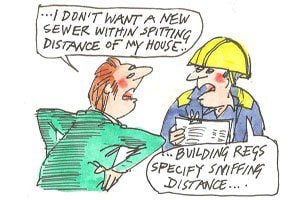Guide to Council Assistance for Private Landlords and Tenants Dealing with Damp and Mould
Damp and mould are persistent issues in many rental properties, posing significant health risks to tenants and causing structural damage to properties.
Addressing these issues promptly is essential for maintaining a safe living environment and ensuring the longevity of the property.
Local councils in the UK offer various forms of assistance to both tenants and private landlords who are struggling with these problems.
This article provides an in-depth guide on how councils help landlords and tenants combat damp and mould, along with the steps that can be taken to prevent and address these issues effectively.
Understanding Damp and Mould: Causes and Effects
What Causes Damp and Mould?
Damp occurs when there is excessive moisture in a building, which can be due to various factors such as:
- Poor ventilation: Lack of proper airflow can lead to condensation, a common cause of damp.
- Structural issues: Leaking roofs, broken pipes, and rising damp from the ground are significant contributors.
- Lifestyle factors: Cooking, bathing, and drying clothes indoors without adequate ventilation can increase moisture levels.
Mould is a type of fungus that thrives in damp conditions. It can cause serious health issues, including respiratory problems, allergies, and asthma. Mould can also deteriorate a property’s structure, leading to costly repairs.
Effects of Damp and Mould on Tenants and Landlords
For tenants, living in a damp and mouldy environment can lead to:
- Health complications: Prolonged exposure to mould spores can cause respiratory illnesses, skin irritation, and other health issues.
- Reduced quality of life: Damp and mould can create an unpleasant living environment, affecting mental well-being.
For landlords, the presence of damp and mould can result in:
- Decreased property value: Persistent damp and mould can reduce the value of a property.
- Increased maintenance costs: Addressing severe damp and mould issues can be expensive, especially if they require structural repairs.
- Legal liabilities: Landlords may face legal action if they fail to address damp and mould problems that affect tenants’ health and safety.
How Councils Assist Landlords and Tenants
Council Inspections and Enforcement
Local councils have the authority to inspect rental properties if they receive complaints from tenants about damp and mould. The inspection process typically involves:
- Initial assessment: A council officer visits the property to assess the extent of the damp and mould problem.
- Health and safety rating: The officer uses the Housing Health and Safety Rating System (HHSRS) to determine whether the issue poses a significant health risk to tenants.
- Action plan: If the property is deemed hazardous, the council can issue an improvement notice, requiring the landlord to take specific actions to remedy the problem.
Financial Assistance and Grants
Councils may offer financial assistance to landlords and tenants struggling with damp and mould. This assistance can take various forms, including:
- Renovation grants: Some councils provide grants to help landlords cover the cost of necessary repairs to eliminate damp and mould.
- Energy efficiency grants: Improving a property’s energy efficiency can reduce damp issues. Councils often offer grants for insulation, double glazing, and ventilation improvements.
- Tenant support: For tenants, councils may offer financial aid to help them temporarily relocate if the property requires extensive repairs.
Mediation and Advice Services
Councils also offer mediation services to help resolve disputes between landlords and tenants over damp and mould issues. This can include:
- Dispute resolution: Councils can mediate between landlords and tenants to agree on a course of action.
- Advice and guidance: Councils provide information on best practices for preventing and addressing damp and mould, helping landlords maintain their properties and tenants live in healthier environments.
Preventive Measures for Landlords
Regular Property Maintenance
Landlords are responsible for ensuring their properties are free from damp and mould. Regular maintenance can prevent these issues from arising. Key maintenance tasks include:
- Roof and gutter checks: Regularly inspecting and repairing roofs and gutters to prevent leaks.
- Plumbing inspections: Ensuring that all plumbing is in good condition and repairing any leaks promptly.
- Ventilation improvements: Installing and maintaining ventilation systems, such as extractor fans in bathrooms and kitchens, to reduce condensation.
Educating Tenants
Landlords should educate tenants on how to prevent damp and mould by:
- Encouraging proper ventilation: Advising tenants to open windows regularly and use extractor fans when cooking or bathing.
- Setting heating guidelines: Informing tenants about maintaining a consistent temperature in the property to reduce condensation.
- Providing dehumidifiers: In properties prone to damp, landlords can supply dehumidifiers to help manage moisture levels.
Diagram: Damp Prevention Strategies
Regular Maintenance
Roof and Gutter Checks
Plumbing Inspections
Ventilation Improvements
Educate Tenants
Encourage Ventilation
Set Heating Guidelines
Provide Dehumidifiers
Legal Responsibilities of Landlords
Compliance with Housing Standards
Landlords must ensure that their properties meet the standards set out in the Housing Act 2004, which includes keeping the property free from hazards like damp and mould. Failure to comply can result in:
- Enforcement actions: Councils can issue notices requiring landlords to carry out repairs.
- Fines and prosecution: Landlords who fail to comply with enforcement notices can face fines or even prosecution.
Handling Tenant Complaints
When a tenant reports damp or mould, landlords are legally obligated to:
- Investigate promptly: Assess the issue as soon as possible to determine the cause.
- Take corrective action: Carry out necessary repairs to eliminate the damp and mould.
- Communicate with tenants: Keep tenants informed about the steps being taken to address the issue.
Conclusion
Damp and mould are serious concerns in rental properties, and both landlords and tenants have roles to play in addressing these issues. Local councils provide crucial support, from inspections and enforcement to financial assistance and advice.
By understanding their responsibilities and taking proactive steps, landlords can maintain healthy living conditions for their tenants while protecting the value of their properties.
Addressing damp and mould not only ensures compliance with legal standards but also fosters a better relationship between landlords and tenants, contributing to a more positive rental experience for all parties involved.
According to recent data, the number of complaints regarding damp and mould in rental properties has been on the rise. In the UK, local councils receive thousands of complaints each year from tenants concerned about damp and mould in their homes.
For example, in 2022, it was reported that over 100,000 complaints related to damp and mould were made to local authorities across England alone.
This figure highlights the widespread nature of the problem and underscores the importance of addressing these issues promptly to ensure tenant safety and compliance with housing standards.
These complaints often result in inspections and enforcement actions by councils, with many landlords being required to undertake repairs or improvements to eliminate the issues.
The increase in complaints reflects a growing awareness among tenants of their rights and the health risks associated with living in damp and mouldy conditions.
This data illustrates landlords’ and councils’ urgent need for effective measures to tackle damp and mould problems in rental properties, ensuring safe and healthy living environments for all tenants.
FAQ About Damp and Mould in Rental Properties
What causes damp and mould in rental properties?
Damp and mould are caused by excessive moisture in a property.
This can result from poor ventilation, structural issues like leaks, or lifestyle factors such as drying clothes indoors without proper ventilation.
What are the health risks associated with damp and mould?
Prolonged exposure to damp and mould can lead to respiratory problems, allergies, asthma, and skin irritation.
It can be particularly harmful to vulnerable individuals such as children, the elderly, and those with pre-existing health conditions.
Who is responsible for dealing with damp and mould in a rental property?
Landlords are legally responsible for ensuring that the property is free from hazards, including damp and mould.
However, tenants also have a role in preventing these issues by properly ventilating the property and reporting any problems to the landlord promptly.
What should I do if I discover damp or mould in my rented property?
If you discover damp or mould in your rental property, you should inform your landlord immediately.
The landlord is responsible for investigating the issue and taking appropriate action to resolve it. If the landlord does not respond, you can contact your local council for assistance.
Can I refuse to pay rent if my landlord doesn’t fix the damp and mould problem?
Refusing to pay rent is not recommended, as it can lead to eviction. Instead, tenants should follow the proper legal channels by reporting the issue to the landlord in writing.
If the landlord fails to act, tenants can seek help from the local council or take legal action.
How can I prevent damp and mould in my rental property?
To prevent damp and mould, ensure proper ventilation by using extractor fans, opening windows, and avoiding drying clothes indoors.
Regularly check for leaks and report any issues to your landlord promptly. Keeping the property at a consistent temperature can also help reduce condensation.
What assistance can the local council provide for damp and mould issues?
Local councils can inspect rental properties, issue improvement notices to landlords, and offer financial assistance or grants for repairs.
They also provide mediation services and advice for both landlords and tenants.
What are the legal consequences for landlords who fail to address damp and mould?
Landlords who fail to address damp and mould issues can face enforcement actions from the local council, including improvement notices.
If they do not comply, they may be fined or prosecuted, and tenants may be entitled to compensation.
Can I improve to prevent dampness and moulding without my landlord’s permission?
Tenants should always seek their landlord’s permission before making any alterations to the property. Unauthorized changes could result in penalties or affect the tenancy agreement.
Are there any grants available for landlords to help fix damp and mould issues?
Yes, some local councils offer grants to landlords for repairs that address damp and mould and improvements that enhance the property’s energy efficiency, such as installing insulation or ventilation systems.
What should I do if my landlord refuses to address damp and mould issues?
If your landlord refuses to address damp and mould issues after you have reported them, you should:
- Document the issue: Take photos and keep records of all communications with your landlord regarding the problem.
- Report to the council: Contact your local council’s Environmental Health department. They can inspect the property and take action if the landlord is found to be neglecting their duties.
- Seek legal advice: If the situation is not resolved, you may need to seek legal advice or assistance from a tenant support organization.
- How long does a landlord have to fix damp and mould issues?
The time a landlord has to fix damp and mould issues depends on the severity of the problem and the terms of the tenancy agreement.
However, landlords are generally expected to act promptly once an issue is reported. For serious issues, the local council may set a deadline for repairs through an improvement notice.
What can tenants do to reduce condensation in their homes?
Tenants can reduce condensation by:
- Ventilating rooms: Open windows regularly, especially in the kitchen and bathroom.
- Using extractor fans: Use fans in areas prone to moisture, such as the kitchen and bathroom.
- Avoid drying clothes indoors: If possible, dry clothes outside or use a tumble dryer vented to the outside.
- Keeping heating consistent: Maintain a steady indoor temperature to prevent condensation on cold surfaces.
What is the Housing Health and Safety Rating System (HHSRS)?
The Housing Health and Safety Rating System (HHSRS) is a risk-based evaluation tool used by local councils in the UK to assess potential hazards in residential properties.
It identifies and rates hazards such as damp and mould, which can impact the health and safety of occupants. If a property is found to have serious hazards, the council can take action to ensure the landlord addresses the issues.
Can tenants be evicted for complaining about damp and mould?
It is illegal for landlords to evict tenants in retaliation for making complaints about the condition of the property, including issues like damp and mould.
This practice, known as “retaliatory eviction,” is prohibited under the Deregulation Act 2015 in England. Tenants who believe they are being unfairly evicted should seek legal advice or contact their local council.
What are the signs of rising damp in a property?
Rising damp is a specific type of damp that occurs when moisture from the ground travels up through the walls of a building. Signs of rising damp include:
- Tide marks on walls: A visible line on the walls, usually up to a meter high, where moisture has evaporated.
- Peeling paint or wallpaper: Dampness can cause paint to bubble or wallpaper to peel away from the wall.
- Salt deposits: White, powdery deposits may appear on the walls as the damp draws salts out of the bricks or plaster.
- Damp smell: A musty odor is often present in areas affected by rising damp.
Can mould damage the structure of a building?
Yes, mould can damage the structure of a building if left untreated. Mould can weaken plaster, paint, and wallpaper, and in severe cases, it can even damage wood and other structural materials. This damage can lead to costly repairs and decrease the property’s value.
How do councils enforce action against landlords who don’t fix damp and mould?
Councils can enforce action against landlords in several ways:
- Improvement notices: Councils can issue a notice requiring the landlord to make specific repairs within a set timeframe.
- Emergency Remedial Action: In severe cases, councils can carry out the repairs themselves and recover the costs from the landlord.
- Prosecution: Landlords who fail to comply with enforcement notices may be prosecuted, resulting in fines or other penalties.
What are the long-term effects of living in a damp and mouldy environment?
Living in a damp and mouldy environment can have long-term health effects, particularly for vulnerable individuals.
Prolonged exposure to mould spores can lead to chronic respiratory conditions, such as asthma and bronchitis, and can exacerbate existing health problems.
In addition, damp environments can contribute to mental health issues, including stress and anxiety.
Are there any insurance implications for landlords with damp and mould issues?
Yes, there can be insurance implications for landlords with damp and mould issues. Most landlord insurance policies require the property to be maintained in good condition.
If a landlord fails to address damp and mould problems, their insurance claim for related damages may be denied. Additionally, persistent issues can lead to increased premiums or difficulty renewing insurance coverage.
These additional FAQs provide further guidance on managing damp and mould issues, ensuring that both landlords and tenants are well-informed about their rights, responsibilities, and the resources available to them.
Useful links related to damp and mould issues in rental properties:
- Shelter provides detailed advice on how to deal with damp and condensation in rental properties, including your rights as a tenant and how to report issues to your landlord.
- GOV.UK – Housing Health and Safety Rating System (HHSRS)
- (The BLA) British Landlords Association – Damp and Condensation
The British Landlords Association is a national landlord association for UK landlords and one of the largest landlord associations in the UK. Join us now for £79.95!
Our top read blogs:
Scotland’s Landlord Exodus and Rental Market Crisis
What is the Process of Renting a Shop
Maintenance Tips to Keep Your Rental Property in Prime Condition
Disclaimer:
This post is for general use only and is not intended to offer legal, tax, or investment advice; it may be out of date, incorrect, or maybe a guest post. You are required to seek legal advice from a solicitor before acting on anything written hereinabove.





